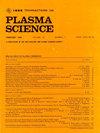A Numerical Analysis for the Detection of Water Salinity Concentration Using Long-Range Surface Plasmon Resonance Biosensor With TMDCs-Teflon/Cytop
IF 1.3
4区 物理与天体物理
Q3 PHYSICS, FLUIDS & PLASMAS
引用次数: 0
Abstract
A novel approach is suggested to enhance imaging sensitivity and refine the figure of merit (FoM) through the utilization of a long-range surface plasmon resonance (LRSPR) biosensor for the detection of water salinity concentration. This design integrates Teflon, copper (Cu), and a transition metal dichalcogenides (TMDCs) layer. By incorporating this composite coating, the biosensor aims to inhibit oxidation, boost biomolecule adsorption, and elevate imaging sensitivity, detection accuracy (DA), and FoM. Using MoS2, MoSe2, WS2, and WSe2 with the Teflon layer, the maximum achieved imaging sensitivities are 27651/RIU, 26501/RIU, 28059/RIU, 27209/RIU at 0% and 33245/RIU, 31458/RIU, 32424/RIU, 30472/RIU at 30%, water salinity concentration, respectively. Further, with the TMDCs layer, the maximum attained DA and FoM values with MoS2 are 33.33/° and 519.13/RIU, with MoSe2 are 50/° and 758.2/RIU, with WS2 are 50/° and 713.12/RIU, and with WSe2 are 50/° and 725.41/RIU, respectively. Additionally, the penetration depth (PD) of 566.12, 566.24, 493.77, and 508.3 nm at 0% and 700.14, 624.35, 570.28, and 569.94 nm at 30% salinity concentration is achieved. The numerical findings are compared to Teflon/Cytop layer-based LRSPR and conventional SPR (cSPR) sensors. We believe that this approach will have valuable applications in biological detection, medical diagnostics, and chemical analysis. While this work is solely based on simulations, we plan to conduct experimental studies in subsequent phases to further validate and refine the obtained numerical results.利用带有 TMDCs-Teflon/Cytop 的远距离表面等离子体共振生物传感器检测水盐度浓度的数值分析
本研究提出了一种新方法,通过利用长程表面等离子体共振(LRSPR)生物传感器来检测水的盐度浓度,从而提高成像灵敏度并改善优点系数(FoM)。该设计集成了特氟隆、铜(Cu)和过渡金属二卤化物(TMDCs)层。通过采用这种复合涂层,该生物传感器可抑制氧化,促进生物分子吸附,并提高成像灵敏度、检测精度(DA)和 FoM。使用 MoS2、MoSe2、WS2 和 WSe2 与聚四氟乙烯涂层,在水盐度浓度为 0% 时,成像灵敏度最高分别为 27651/RIU、26501/RIU、28059/RIU、27209/RIU;在水盐度浓度为 30% 时,成像灵敏度最高分别为 33245/RIU、31458/RIU、32424/RIU、30472/RIU。此外,在 TMDCs 层中,MoS2 的最大 DA 值和 FoM 值分别为 33.33/° 和 519.13/RIU,MoSe2 的最大 DA 值和 FoM 值分别为 50/° 和 758.2/RIU,WS2 的最大 DA 值和 FoM 值分别为 50/° 和 713.12/RIU,WSe2 的最大 DA 值和 FoM 值分别为 50/° 和 725.41/RIU。此外,渗透深度 (PD) 在 0% 浓度时分别为 566.12、566.24、493.77 和 508.3 nm,在 30% 浓度时分别为 700.14、624.35、570.28 和 569.94 nm。这些数值结果与基于聚四氟乙烯/Cytop 层的 LRSPR 和传统 SPR(cSPR)传感器进行了比较。我们相信,这种方法将在生物检测、医疗诊断和化学分析中得到有价值的应用。虽然这项工作仅基于模拟,但我们计划在后续阶段开展实验研究,以进一步验证和完善所获得的数值结果。
本文章由计算机程序翻译,如有差异,请以英文原文为准。
求助全文
约1分钟内获得全文
求助全文
来源期刊

IEEE Transactions on Plasma Science
物理-物理:流体与等离子体
CiteScore
3.00
自引率
20.00%
发文量
538
审稿时长
3.8 months
期刊介绍:
The scope covers all aspects of the theory and application of plasma science. It includes the following areas: magnetohydrodynamics; thermionics and plasma diodes; basic plasma phenomena; gaseous electronics; microwave/plasma interaction; electron, ion, and plasma sources; space plasmas; intense electron and ion beams; laser-plasma interactions; plasma diagnostics; plasma chemistry and processing; solid-state plasmas; plasma heating; plasma for controlled fusion research; high energy density plasmas; industrial/commercial applications of plasma physics; plasma waves and instabilities; and high power microwave and submillimeter wave generation.
 求助内容:
求助内容: 应助结果提醒方式:
应助结果提醒方式:


